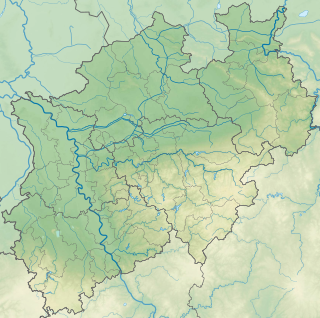Möhnsee area
| Möhnsee area | |||
|---|---|---|---|
| The Möhnesee area consisting of the Möhnesee and the northern part of the Arnsberg Forest south of the reservoir (left in the picture). | |||
| Systematics according to | Handbook of the natural spatial structure of Germany | ||
| Greater region 1st order | Low mountain range threshold | ||
| Greater region 2nd order | Rhenish Slate Mountains | ||
| Main unit group | 33 → Süderbergland |
||
| About main unit | 334 → North Sauerland Oberland |
||
| 4th order region (main unit) |
334.2 → Lower Arnsberg Forest |
||
| Natural space |
334.21 → Möhnsee area |
||
| Geographical location | |||
| Coordinates | 51 ° 28 ′ 54 " N , 8 ° 8 ′ 11" E | ||
|
|||
| local community | Möhnesee , Arnsberg , Warstein | ||
| state | North Rhine-Westphalia | ||
| Country | Germany | ||
The Möhnsee area is a natural sub-unit with the order number 334.21 of the Lower Arnsberg Forest ("Eichwald") (334.2) within the North Sauerland Oberland (334). According to the handbook of the natural spatial structure of Germany, it comprises the gently undulating main part of the Lower Arnsberg Forest on the border to the open Hellwegbörden (542), which is 350 to 300 m above sea level. NN and extends along the 70 m deep longitudinal valleys of the Möhne and the lower Heve .
The natural area is predominantly in the municipality of Möhnesee with smaller parts in Arnsberg in the southwest and Warstein in the east. The Möhnestaussee occupies a large area of the Möhnesee area, which lies entirely in the natural area and serves as a drainage reservoir for most of the North Sauerland Oberland (334). It is a popular recreation and water sports area on the edge of the Arnsberg Forest nature park .
The Lower Arnsberg Forest with the Möhnesee area can be distinguished from the Upper Arnsberg Forest (334.3) to the south by a much flatter terrain and a milder climate with 800 to 900 mm of precipitation and a May / July mean temperature of 14 to 15 ° C. The soils, on which, in contrast to the Upper Arnsberg Forest (“Buchwald”), in addition to large-scale coniferous forests, mostly oak forests are to be found, are sandy-loamy, and in some cases also podsolic .

